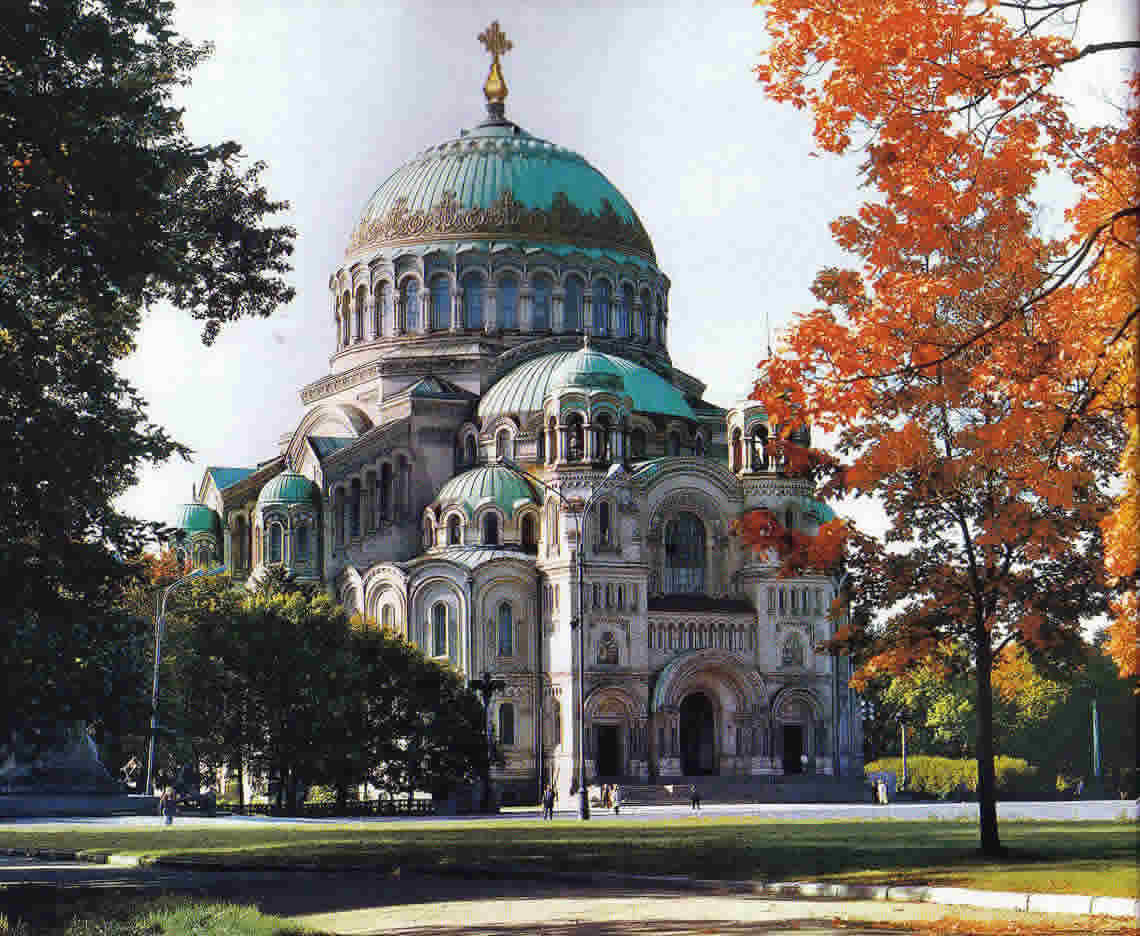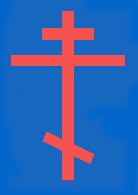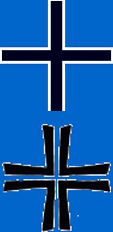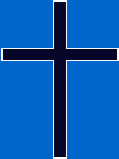The Cyrillic script and the Old Church Slavonic language
The roots of the Russian orthodoxy lie outside Russia, in the Balkans. The Cyrillic Script wasn’t created by Cyril, and Cyril’s original name was Konstantin.
The ”Apostles of the Slavs“ , the brothers Cyril and Method (Michael) came from Thessalonica, a town then on the borderline between Slavs and Greeks. They knew both languages: the language of the Macedonian Slavs, and Greek. They were invited to the Great Moravian Empire in 863 or 864 to help to spread Christianity among the subjects of this empire. The duke of Great Moravia, Rastislav, with their help wanted to diminish the influence of the Bavarian missionaries who had been promoting Christianity up to this moment in his lands. The Bavarian rulers had in this way tried to gain influence in the Great Moravian Empire, and Rastislav tried to counter their activities.
The Great Moravian Empire’s whereabouts and boundaries are not clearly defined. It is generally assumed that its centre – unknown till today – was in nowadays Moravia. Cyril and Method followed his call and founded a school for Slav-Christian religion – the Slavonian Academy – that may have been where the castle of Devin is, in nowadays Slovakia. The parishes they were given had their centres in the towns of Nitra (nowadays Slovakia) and Syrmium (nowadays Sremska Mitrovica in Serbia). Some historians believe that the centre of the Great Moravian empire might have been in nowadays Croatia. The sources to determine these assumptions are scarce and unclear, the national political ambitions both fuelling and impeding research are strong.
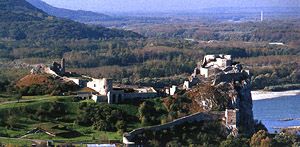 |
Devin castle above the Danube, near the mouth of the
Morava |
Cyril and Method therefore set out for a mission that was not only religious, but very political. Their emperor, Michael III. of Constantinople, this way also wanted to gain influence among the Slavs. He supported them with all means within his possibilities.
In the course of this mission Cyril created a script, the Glagolica. The sources of the Glagolica are disputed.
| The dispute around the origin of this script is connected to the question whether the Slavs had a script at all or were completely illiterate until the appearance of the apostles. The most widely accepted theory is that they had no script and Cyril created this script out of a Greek script, as at this stage there were different Greek scripts. It almost in no letter resembles nowadays Greek or Slav Script. Therefore the assumption that there was a Slav script cannot be completely dismissed. | Entrance into the castle of Nitra |
 |
Cyril translated the Bible into a Slav language that was based on the Macedonian dialect, with many words from the Slavs of the Great Moravian Empire. In this way he did not only create a script for the Slavs, but also a language that became the liturgical language of the whole Eastern church, the Old Church Slavonic. With modifications – approaching the national languages – it continues to be the language of the orthodox Slav churches. In medieval Russia or the Balkans it was the language of the scholars, as Latin in the Western church. For a very short time ( 868-886) it was acknowledged by Rome as a liturgical language.
The only country that uses and hails the Glagolica nowadays – as a symbol of national identity – is Croatia, a country that doesn’t adhere to any Eastern/orthodox church, but considers itself a stronghold of the Roman church. The Glagolica is even printed on the 100 Kuna-bill.
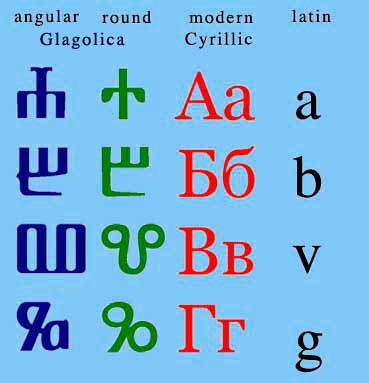
The Cyrillic script that is used today by Serbia, Bulgaria, Makedonia, Russia, Ukraine, Belarus and several Middle Asian countries was created by a disciple of Method, Kliment, who together with the other adherents of Cyril and Method had been expulsed from Great Moravia by a Svabian envoy of the pope after Method’s death. The Slavonic Academy had been closed. This expulsion of the Slavic monks from Central Europe and the prohibition of the Old Church Slavonic language in liturgy in 886 by the pope are considered important steps towards the Great Schism between Eastern and Western church, between Byzantium and Rome.
Kliment was ordered to create or new, more simple script for the Slavs by the Bulgarian tsar Simeon I. (ruled 893-927). Simeon in 918 had founded an own national church, the Bulgarian Patriarchate, and wanted to challenge the leading role of Constantinople by becoming the head of Slavonic orthodoxy. For translations of the Bible and correspondence in church affairs he wanted a script with more simple and straight letters than the Glagolica. This new script was certainly based on the Greek, Kliment only used some letters of the Glagolica for sounds that did not exist in Greek.
In Russia the Cyrillic script was reformed in the time of Peter the Great. In these reform movement again the script should be simplified and made more easily read- and writeable. This time the ruler had even more worldly affairs in mind, and foreigners used to Latin script: With the new script, also called ”civilian“ , Peter wanted to foment Russia’s approach to Europe. These changes were partially followed by other countries which also use the Cyrillic script.
The last substantial changes were made after the Great October Revolution. Since 1918 the Russian Cyrillic script has remained the same.
The beginnings of the Russian church
Christianity came to the Russians through Kiev, perhaps the oldest city of Europe, ”the mother of all cities“ .
The ”Baptism of the Rus“ , that is the mass conversion to Christianity by the inhabitants of the first Russian empire, the Kievian Rus, is linked to the name of the Kievian Grand Duke Vladimir Svjatoslavjevich, the ”Golden Little Sun“ , and the year 988. All this is more based on myths, or state and clerical propaganda, than on facts.
| Decoration above the entrance of St. Nicolas Church in Kronstadt | 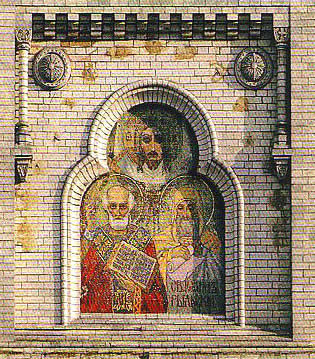 |
The rulers of the Rus already for some time tried to determine and unify the beliefs of their subjects in order to create a stable base for an empire. The Kievian Grand Dukes Askold and Dir as early as 866 attacked Constantinople, then agreed on cooperation and somehow were baptized there. They didn’t succeed in introducing this religion at home and were killed by their successor Oleg. Later the Grand Duchess Olga tried to introduce Christian beliefs to the Rus, also in vain. Vladimir first tried to strengthen the old heathen beliefs of the Slavs, had a temple erected for the pagan gods and persecuted the Christians. But then he started to look for allies and stage hearings of representatives of various religions, Jews, Muslims and Christians. Finally he decided to side with Constantinople, took the sister of the emperor as wife and converted to Christianity.
All the allegations that have been made about this conversion have never been proven. Some sources state that he was baptized on Khersones (today Sevastopol) on the Crimea, others state he had himself baptized in Kiev and most of the inhabitants of the city followed him in a kind of mass hysteria down to the river to follow his example, rushing along the street that is today called the Kreshchatik, the Street of Baptism. The only thing that can be said for sure is that this is the version that was promoted by Vladimir himself and his successors. A kind of medieval propaganda.
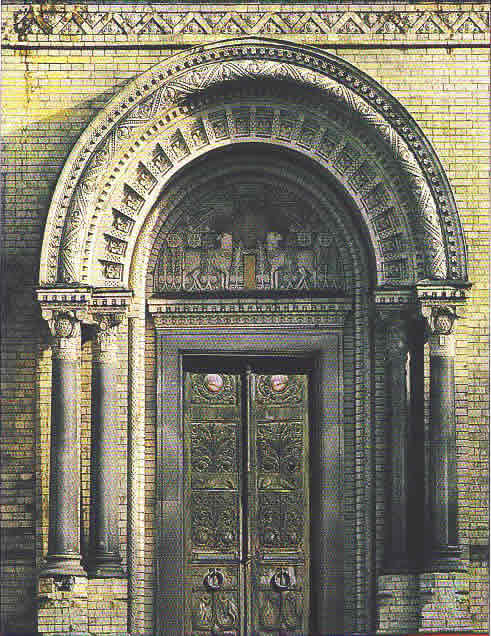 |
The main entrance to the St. Nicolas Cathedral in
Kronstadt. |
Perhaps conversion wasn’t so voluntary. Certainly there was resistance in other cities of the Rus, as accepting this conversion meant subjection to Kiev.
Arab sources also mention that later Vladimir converted to Islam
– without abandoning Christianity, either. He liked polygamy, had lots
of harems and his countless sons took over other cities of the empire, fought
against each other and outer enemies till the Mongolian invasion of 1240 that
led to the complete destruction of Kiev and the end of the Rus. Then followed
the centuries of the Mongolian yoke.
For someone not experienced in religious affairs, more so for an atheist, it is very difficult to understand the differences between the Orthodox and the Roman church, the antagonism and even at times bitter infighting between them. It is evident that mostly it has been a struggle for power and influence, trying to gain territory that belonged to the adversary.
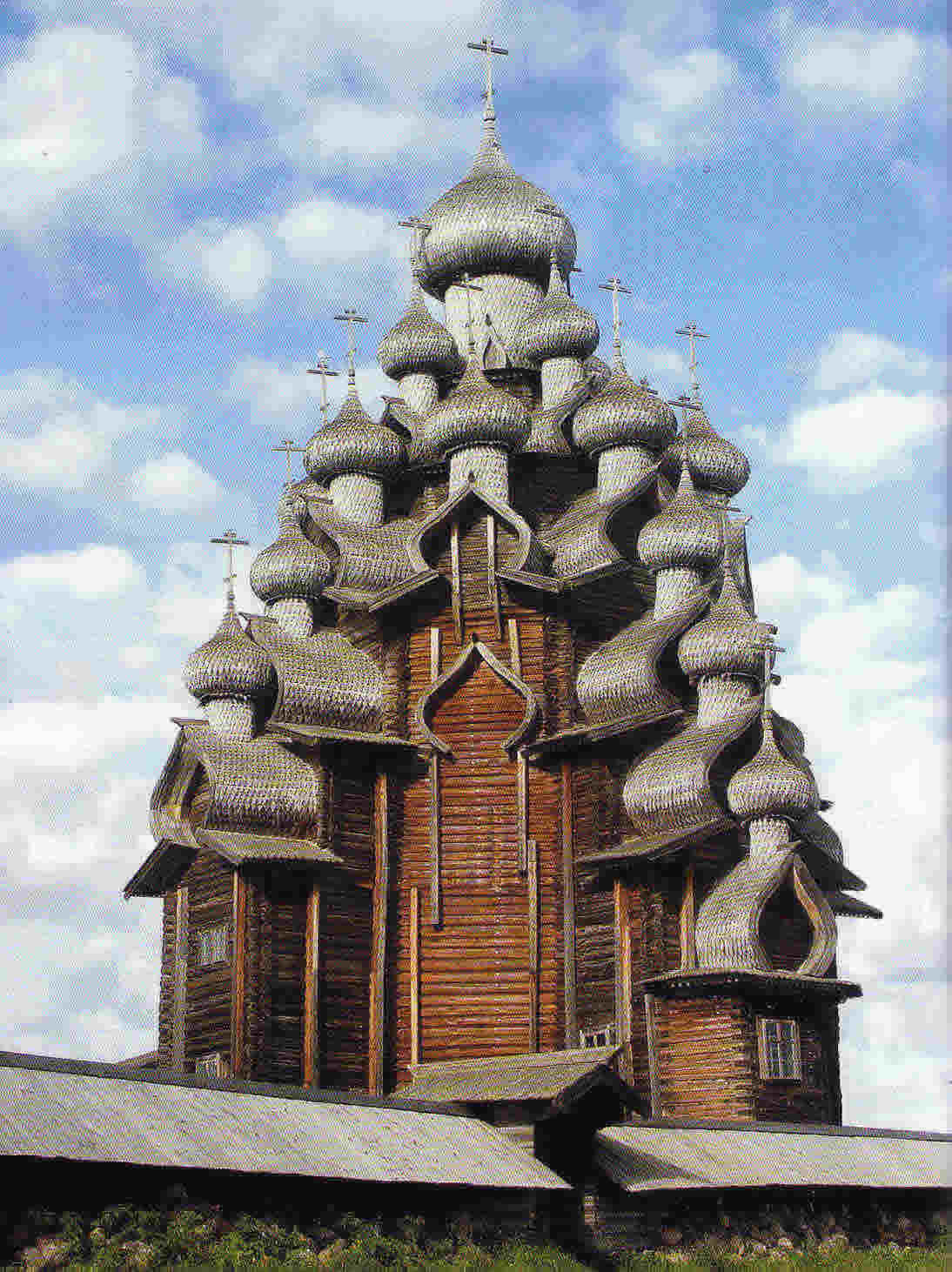 |
The Preobrazhenskaya (transformation) church, part of the museum of rural architecture on the island of Kizhi, in Lake Onega. It has been in a bad state for many years, due to the extreme humidity and winds on this island on Lake Onega. There are continuous attempts to restore it. The restoration works are progressing. The church has been supported from inside with a strong scaffolding and now its various floors are being partially lifted with jacks in order to exchange the decayed beams which are numerous given the age of the church and the humidity of the lake and its surroundings. The restoration works have started years ago. The church isn’t accessible to the public. There are calculations that the restoration will last until 2014. |
As to the differences of liturgy and dogma, the unified churches of Eastern Europe are closer to many orthodox churches, than to most catholic ones. Also among the Catholics there are wider gaps and animosities between Latin American branches and Rome, than between for example Serb and Russian orthodox churches.
The Preobrazhenskaya church is a ”summer church“ , it cannot be heated. In winter the people used the other church beside it in the ”pogost“ (religious centre of a village or even some villages) of Kizhi, the Pokrovskaya (protection) church.
Detail from the church above. The wooden shingles are made by hand and should be from asp tree which is considered the best wood for these shingles. Some of those onion dome roofs are left in their natural colour, some are painted. The ones in Kizhi are painted in silver. |
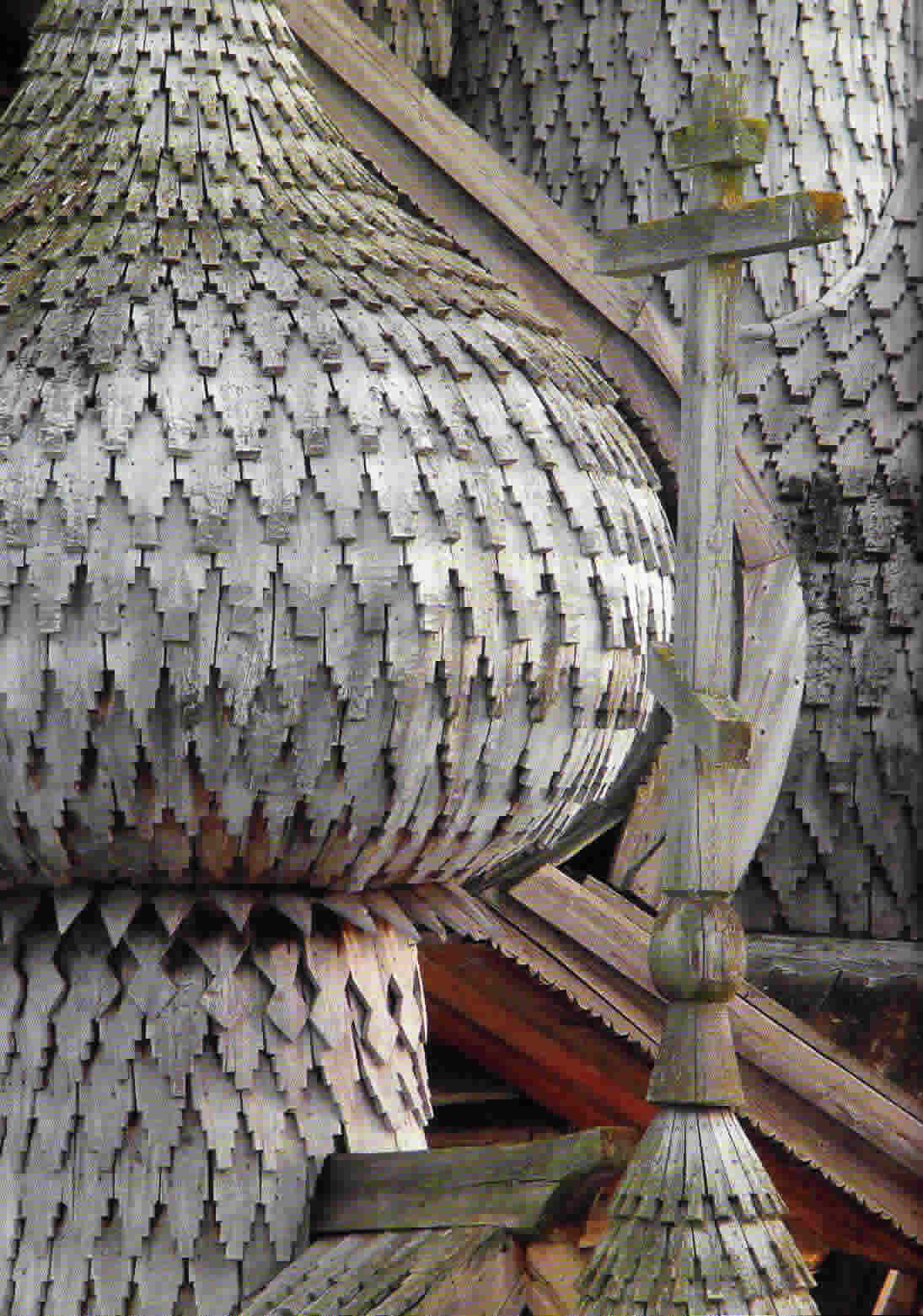 |
I believe the main difference between Roman and Eastern church is in the relation between ecclesiastical and worldly power. The orthodox churches are national churches, the priests and patriarchs always considered themselves the first patriots of the country and their most important aim was to serve their nation. The rulers of the countries of orthodox faith knew they could count on their clergy in their nation-building. And Constantinople always consented to the idea of national churches, as a means of still maintaining themselves as the main ally of those new entities, states or dioceses. So Simeon founded a Bulgarian Patriarchate in 917, and Stefan Dušan founded a Serb Patriarchate in 1346. Orthodoxy has played a decisive role in the Balkans: it was the Serb resistance, backed by their church, that finally drew out the foreign rulers out of the Balkans.
A different relationship than with the Balkan’s rulers developed between Constantinople and Russia.
When the Kievian Rus converted to Christianity Constantinople won a powerful ally. This alliance strengthened the Byzantine Empire and helped it survive for some more centuries by pacifying its northern border. To the Rus it gave unity and, for the first time, a real identity. Till then they had been torn between Slav rites and habits, other pagan rites, and the influence of the Viking (Rurik) dynasty ruling them. The alliance with Constantinople led to an influx of scholars and artists from all over the Byzantine Empire. The civilian city culture rose to a level unknown hitherto, and the political-military aspect should not be underestimated: It secured the southern frontier of the Rus and gave them the opportunity to establish themselves in the region. The only serious threat now came from the western border, from Lithuania and Poland. This was to a great extent due to the emerging antagonism towards the Roman-German Empire, the alliance of the German rulers and the Pope.
|
The Kievian Rus never saw a reason to emancipate itself from
the Byzantine Empire. It remained under the Patriarchate of Constantinople.
When the Mongolians destroyed Kiev nearly completely, and also
other cities of the Rus, the only source of identity that remained was the religious
and cultural alliance with Constantinople. For more than a century the Russian
church was busy with infighting, fighting heresy and trying to establish unity.
Meanwhile, first the city-empires, successor states of the Rus fought against
each other, often with the help of the Mongolians.
Then Constantinople, already visibly debilitated for a certain
time, fell to the Ottomans in 1453.
But that was the time when Russia started to reunite, under
the reign of Grand Duke Vassili and his son, the first (Muscovitie) Tsar Ivan
IV (the Terrible). The fall of Constantinople gave the Russian Empire further
legitimation to assume the role of the successor of Constantinople which had
called itself for a short time called ”New Rome“ : Moscow felt itself
entitled to play the role of a successor of ”real faith“ , thus it
claimed to be the ”Third Rome“ . In terms of the orthodoxy, this has
a certain legitimation even today: it is the biggest orthodox state, at least
by inhabitants – perhaps not by believers, as there is an atheist legacy
from Soviet times, and Russia has many religious minorities: Muslims, Shamanists,
Buddhists. But the Russian orthodox church is gaining followers day by day.
|
A man on the Crimea who was very religious once tried to convince
me of his point of view, back in the 90-ies. Perhaps this also refers to the
time of the Mongolian yoke: ”Look what has happened, he said. The state
has fallen apart, but God has remained!“
The reunification of the Russian lands was both a precondition
and a result of the strive for unity within the church.
In a desperate attempt to gain allies against the pressure of the Ottoman Empire some prominent Greek church authorities declared the unification of the Eastern churches with the Church of Rome at the Council of Florence in 1439. In vain, as Constantinople was still left to itself and was conquered a few years later. The Russian clergy rejected this decision, which had no influence on other orthodox churches, either. As a consequence the Russian church elected an own metropolitan in 1448 which then led the Russian church affairs independently from outside influence. An own Russian Patriarchate was established during the regency of the later tsar Boris Godunov in 1589, the first Muscovite patriarch being consecrated by the the representative of the over-all orthodox church, patriarch Jeremy from Constantinople.
The Russian art of icon painting has survived from the medieval ecclesiastic art. It still uses the technique established in the Byzantine Empire. Wooden boards are prepared with a grounding. The paint that is used is tempera paint, based on raw eggs. Tempera is a mixture of oil, water, glue and natural substances. The paint has to be mixed immediately before being applied as it cannot be conserved. The technique is also difficult and requires long training and a lot of skill.
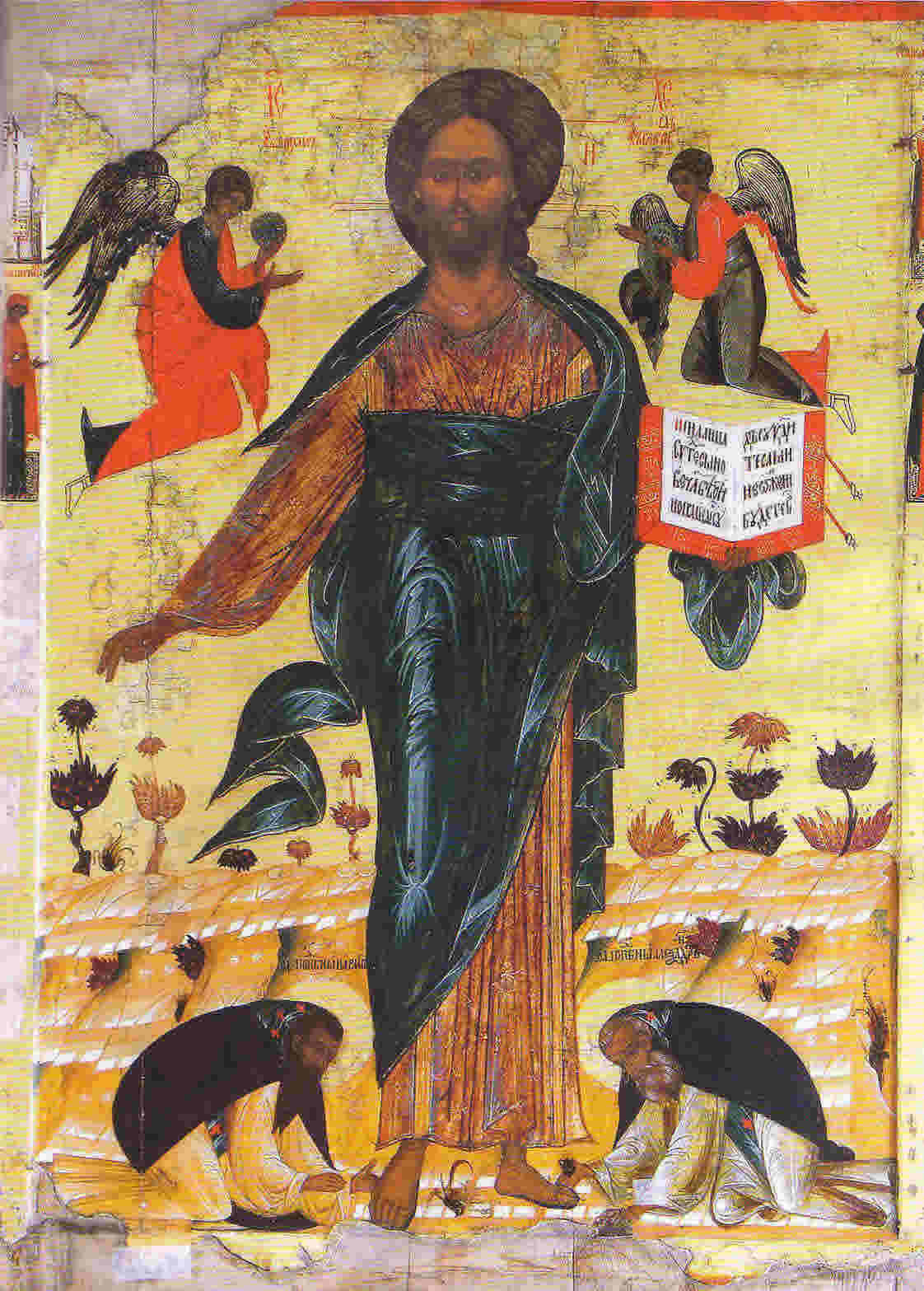 |
Detail from the iconostasis below, from Kizhi |
Icons can only be painted by someone who firmly believes in God. The icon isn’t picturing real things but transcendent affairs. It is meant to communicate the believer to the Lord, the saints and paradise. The icon is meant to solve the contradiction between living in the reality and believing in an outer world. Therefore all of it is symbolic. The colours resemble various aspects of faith, such as Trinity, Creation, Immortality, and so on. A hill, for example, is not a hill but a symbol of ascension towards the reign of heaven. Every single detail of the icon is a hint for something divine, saint and unearthly. So apart from the techniques of painting the icon painter has to have a profound knowledge of the symbolic means of each colour and each feature of an icon.
| Another icon at Kizhi, brought there from another church in the surroundings | 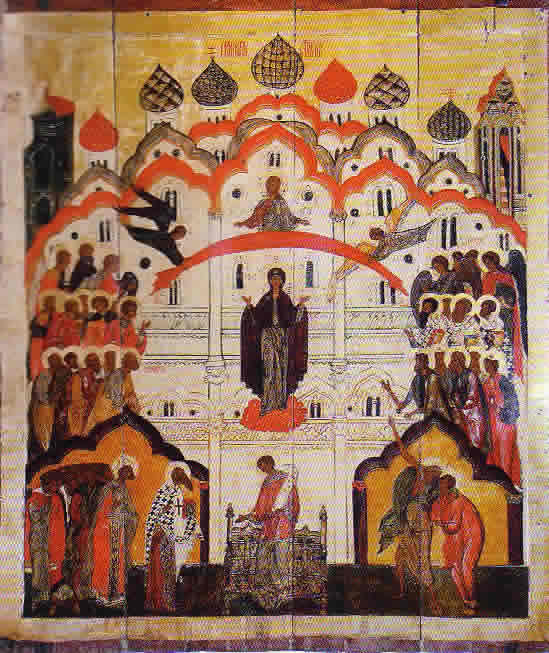 |
Gold is the colour of the divine, but also the infinite. Gold as a background to an icon painting means that the painting has no background, and the figure on it more or less floating in space. This is why gold is such a prominent colour on Russian icons, and has always made the churches very attractive for robbers and plunderers. As a consequence of that it led to the fortification of churches and monasteries within the ”kremlins“ that could even resist attacks and sieges from hostile armies.
The iconostasis, the wall of icons separating the believers from the room where the priest prepares mass is the border between the earthly and the divine.
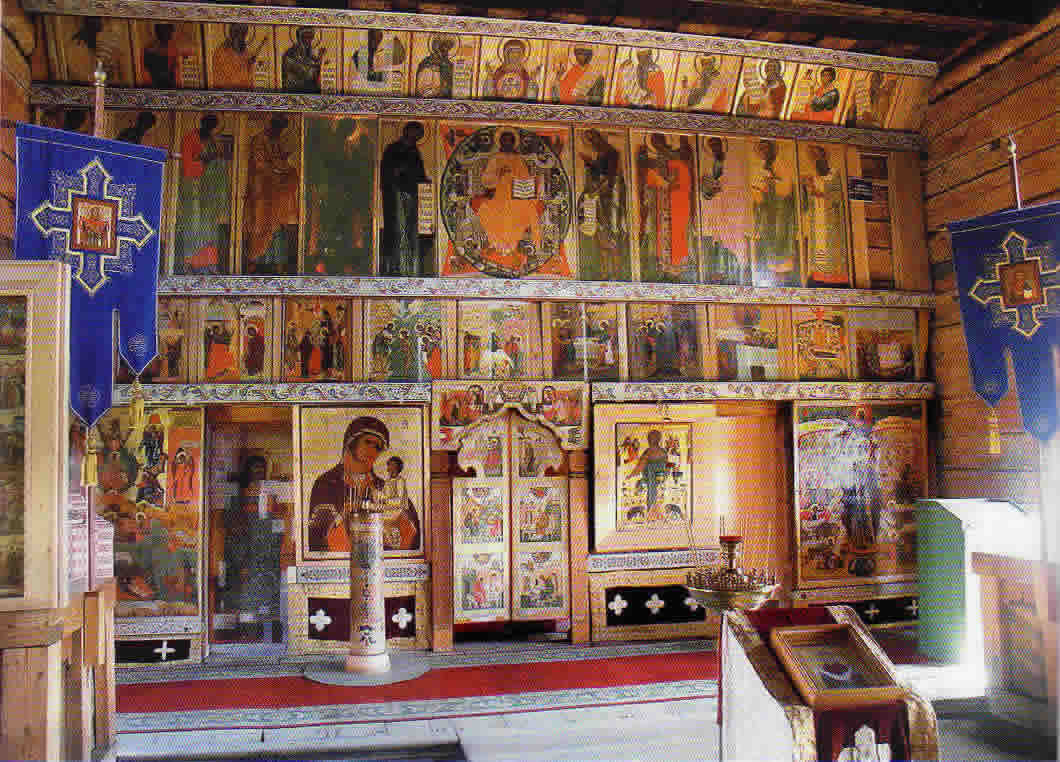 |
The iconostasis in the Pokrovskaya (protection) church in Kizhi. |
The Russian art of icon painting was introduced by the Greek
missionaries and for centuries followed exactly the norms established by their
Greek fellow painters. The icons of the Kievian Rus, as far as they have been
preserved, resemble the Byzantine art of painting.
The greatest and most probably last Greek icon painter who
practiced his art in the Russian lands was Theophan Grek in the 2nd half of
the 14th century. He influenced all his Russian contemporaries and his legacy
gave birth to an own and independent Russian icon art. He was one of the teachers
of the most famous Russian icon painter of all times, Andrei Rubljov. His influence
on Russian painting can perhaps be equalled to El Greco’s impact on Spanish
art.
"Preobrazhenie“ – Metamorphosis, Transformation Icon presumably by Theophan Grek in the Spasso-preobrazhenski (Saviour and transformation) cathedral in Pereslavl-Zalesski |
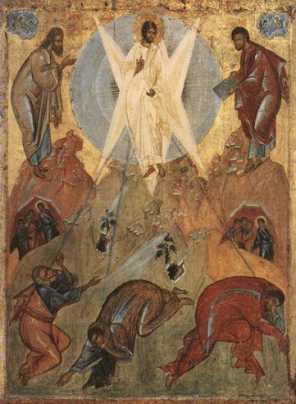 |
In his film ”Andrei Rublyov“ the director Andrei Tarkovski gives his partly fictitious, partly realistic account of those times and of the relationship between the two artists. The outgoing 14th and beginning 15th century was a part of the dark times of the Mongolian yoke. Besides the bloody feuds between the various Russian Grand Dukes of Novgorod, Moscow, Vladimir and other smaller principalities the raids of Tartar hordes took place, and there was also a cruel persecution of the adherents of pagan beliefs and rites by the church authorities anxious of their power.
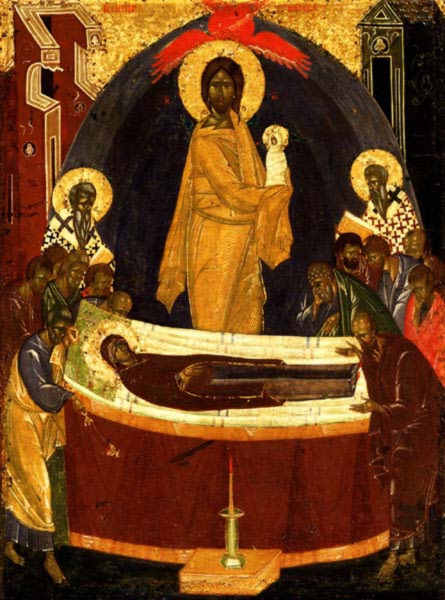 |
"Uspenie Bogoroditsy“ – the assumption of the one who gave birth to God
Icon attributed to Theophan Grek at the back side of another icon, the Godmother of the Don, in Kolomna. |
In this film Theophan Grek, as the representative of a doomed empire tells his
opinion of the world to the young monk who doesn’t know it but he is the
member of a great empire-to-be: ”If Christ were to walk again among us
he would again be crucified.“
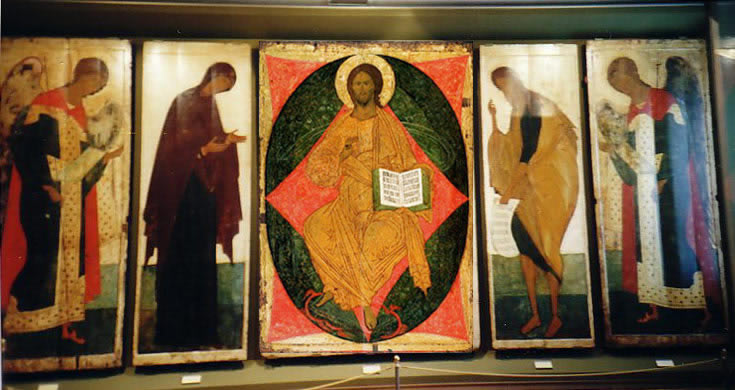 |
Andrei Rublyov and Danila Chorni, ”Spas v silakh“ – Christ the saviour amidst his followers and helpers. Tretyakov gallery, Moscow. |
Icon painting is on the rise again. Various schools have been established and are practicing. The most renowned is in the town that has emerged as the centre of orthodox scholarship and art: Sergiev Posad (former Zagorsk).
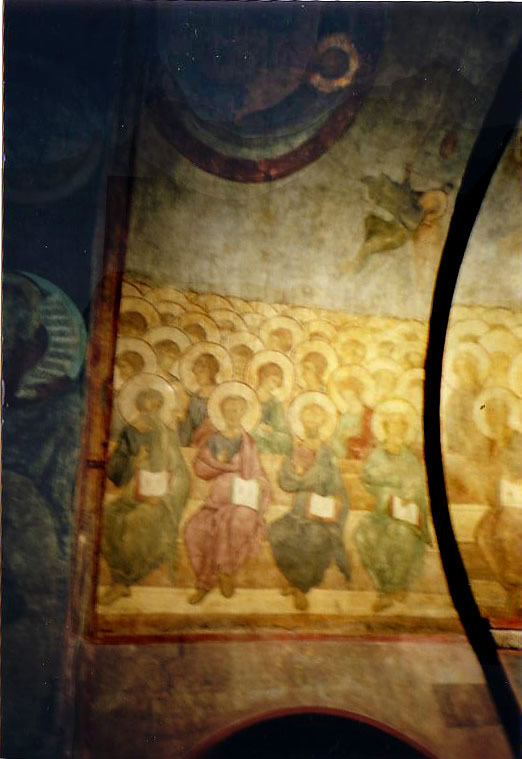 |
Part of the painting ”The Last Judgement“ from Andrei Rublyov at the ceiling of the Uspenski (assumption) church in Vladimir
Detail |
 |
